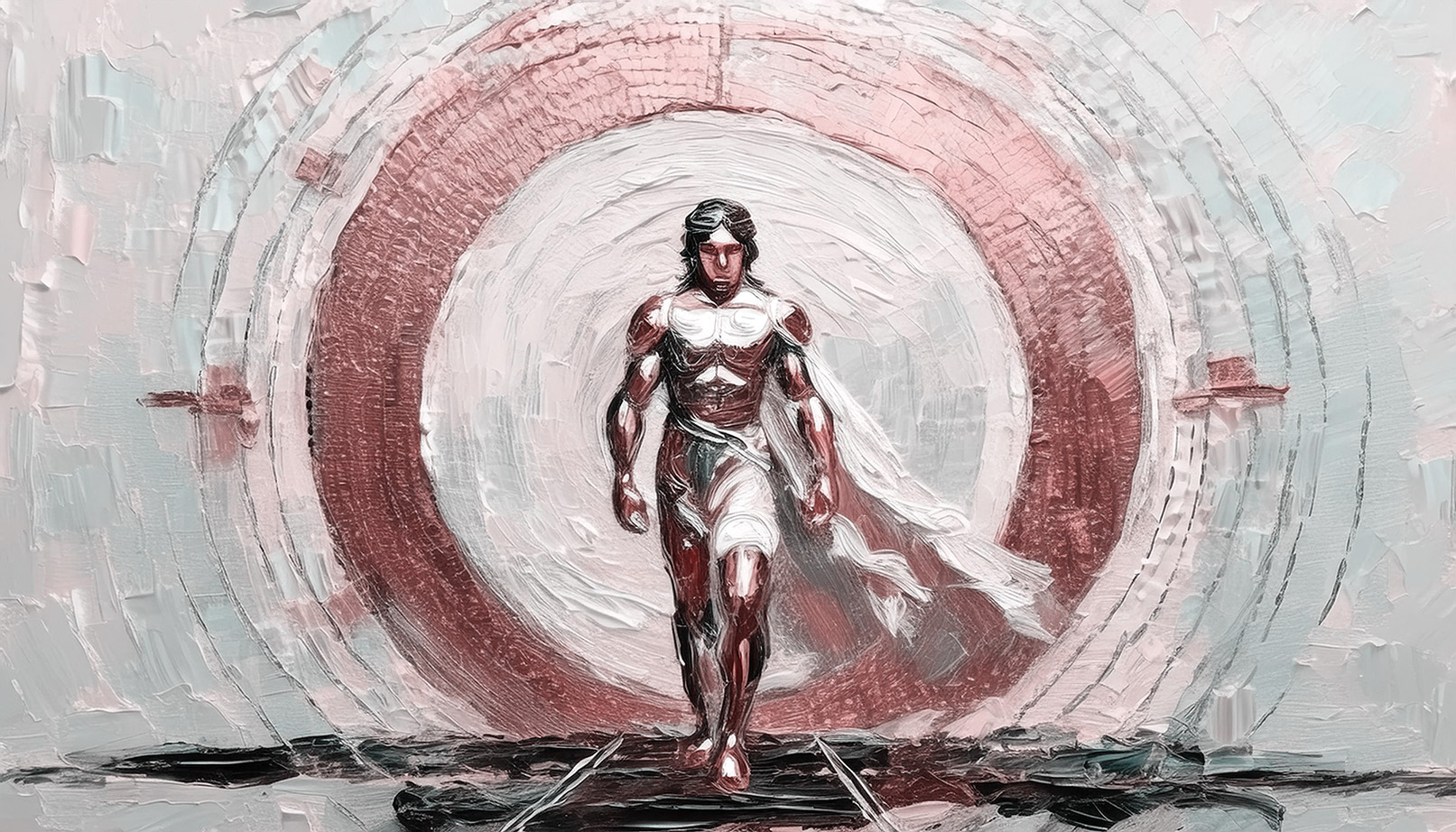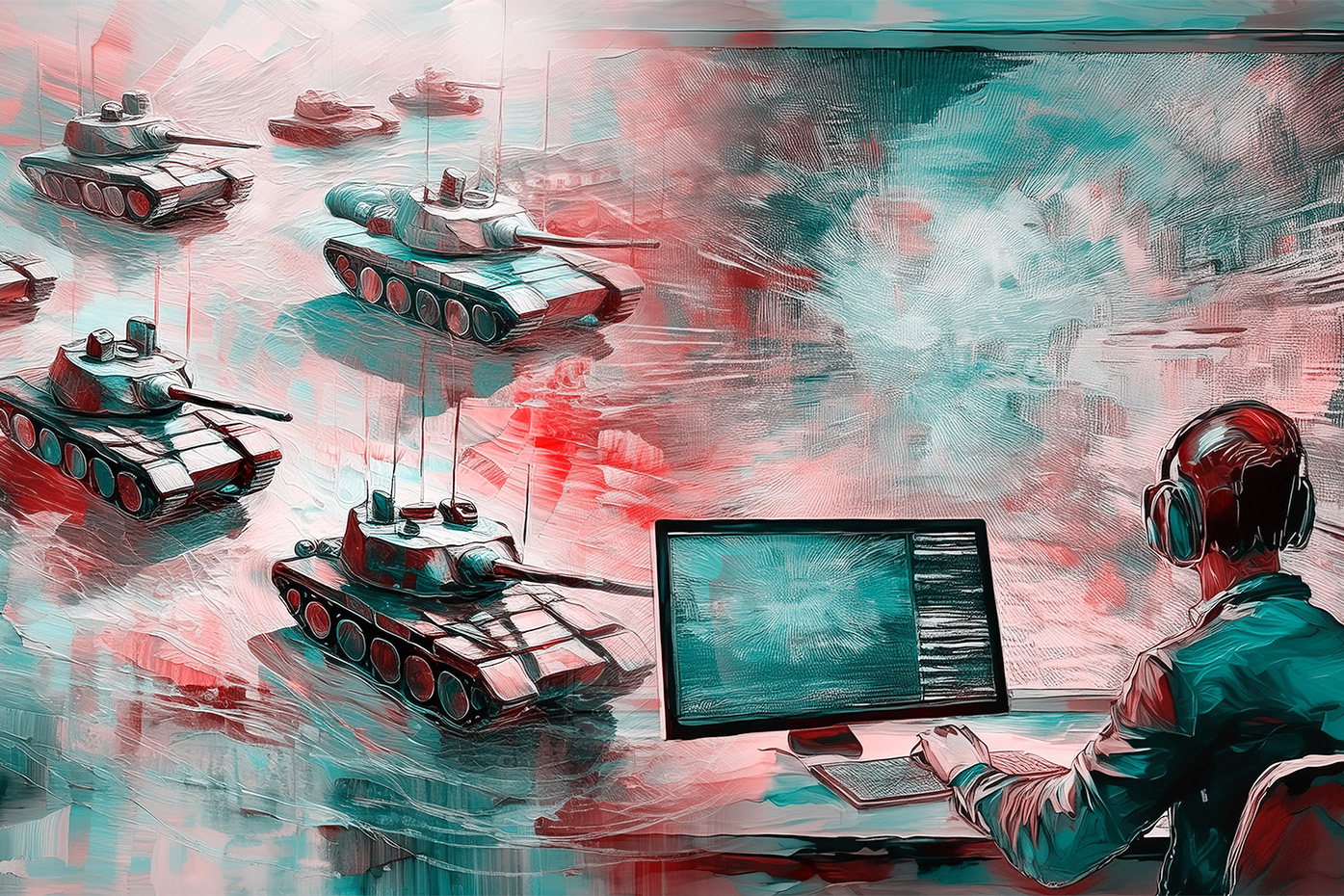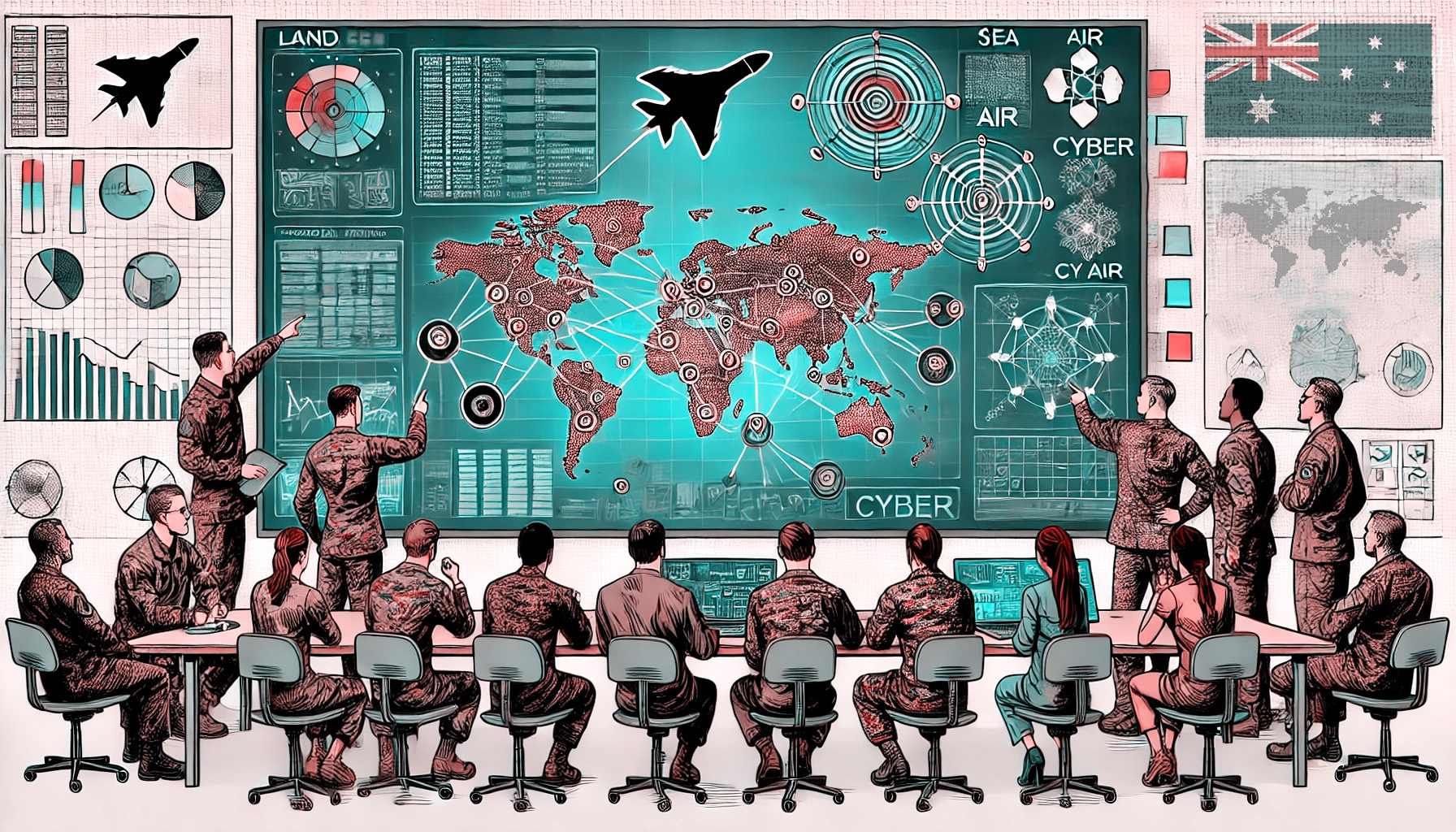Introduction
The Australian Defence Doctrine Publication (ADDP) 5.0.1—Joint Military Appreciation Process (JMAP), aims to provide guidance for planning Australian Defence Force campaigns and operations.[1] The JMAP consists of five steps, from Scoping and Framing to Decision and Concept of Operations Development. Step two of the process involves Mission Analysis. Sub-step two of Mission Analysis involves deriving and analysing Centres of Gravity (COG). The COG concept was adopted after the Vietnam War by the United States Army in a frantic search for concepts to keep warfighting relevant and to avoid another US defeat. An interest in Prussian military theory, particularly the new translation of Clausewitz’s On War published in 1976, ensued.[2] Clausewitz defined the COG concept as ‘the hub of all power and movement, on which everything depends.’[3] More than any other, the concept of COG remains ingrained in Western military doctrine, ‘although often as a source of confusion rather than clarity’.[4] Although COG analysis only takes up 12 pages of the JMAP, ‘obedience to technical rationalism has made the centre of gravity the ‘centre of gravity’ of the ADF and other Western military’s planning processes.’[5] There has been no shortage of debate among academics and practitioners that COG analysis is a flawed concept that no longer has any relevance in today’s campaign planning. Despite the criticism, there appears to be a reluctance to remove the metaphor from Western doctrine due to an apparent ‘sales resistance’ in adopting meaningful changes.[6]
To determine the applicability of the COG step within the JMAP to Defence, this essay will first look at the problems of using a physics metaphor to aid military planning and decision making. Second, this essay will compare the ADF JMAP with other Western military planning processes and discuss why the choice of theory matters, citing a hypothetical analysis of the US and NATO defeat in Afghanistan.[7] Finally, this essay will demonstrate that COG is outdated, confusing, and no longer applicable to the ADF and other Western planning doctrines. The paper will contend that the concept could be removed from the JMAP altogether or that other pragmatic alternatives could be adopted.[8] Perhaps, controversially, Clausewitz’s Western strength-against-strength concept could be replaced with Eastern thinking and the strength-against-weakness principle.
The problems of using a physics metaphor in military planning processes
The Clausewitzian COG concept is inexorably woven into the planning doctrines of the ADF and its major Western allies, including NATO and the US. However, using a physics metaphor to underscore how plans are created is problematic.
‘When we use metaphors to define something, we do not really understand it.’
On the one hand, COG is held up as the crux of military wisdom vital to ensuring effective operational planning. Conversely, it is an unsatisfactorily applied physics analogy of little practical use.[10] It has even been likened to ‘rearranging the deck chairs on the Titanic’.[11] The term COG is widely misunderstood, as evidenced by the prodigious amount of literature by numerous academics trying to articulate its meaning. The result is that there is no clear answer. Despite this, rigid Western militaries, including NATO, the US, and the ADF, remain determined not to do away with the term and use it as the cornerstone of their planning doctrines. The concept of COG coined by Clausewitz was taken from the physics of the period and ‘became one of his most unsatisfactory contributions to strategic thought’.[12] Even physicists have numerous definitions for the term. The Oxford English Dictionary defines COG as the ‘central point in an object, around which its mass is evenly distributed.’[13] The rationale for the metaphor is that the static equilibrium would be disturbed and topple if an enemy was attacked at its COG. However, the problem is that although it may be straightforward to pinpoint the COG of a static object, it is much more challenging to do so with a moving, unpredictable enemy.[14] Somewhat ironically, though, while a physics metaphor, identifying a COG in military planning remains more of an arcane art than science.[15]
To further illustrate the problems with using the metaphor, it is helpful to delve into the JMAP document itself. First, the preface states that ‘COG analysis has been retained. However, the methodology employed to conduct the analysis has been revised.’[16] One could argue from this statement that there has been doubt about the concept and debate on whether to keep it. It states that ‘COG analysis has been de-emphasised to better enable the planning process to be applied during unopposed as well as opposed campaigns and operations.’[17] It would be helpful to understand why it was necessary to de-emphasise the analysis to make it more applicable to unopposed operations and what was de-emphasised. However, this information is not provided. It is not difficult to understand why there was likely a debate on COG retention in the doctrine if we return to the metaphor once more and ask, ‘What actually is the COG, and how does one find it?’ ‘Unfortunately, there is not a single answer to those questions.’[18] Second, in sub-step 2 of ADDP 5.0.1, despite the detailed de-emphasis, it states, ‘some contemporary writers have argued that the metaphor is over-emphasised and should be interpreted more as a focus on key considerations.’[19] To further understand the problems with the COG concept, it is useful to look at the process of the JMAP co-authorship by Dr Aaron P. Jackson and Squadron Leader James Rea. Interestingly, the COG was the subject that attracted the most intense, time-consuming debate.[20] Furthermore, during the co-authorship and indicative of the complexity of analysing COGs, Dr Jackson noted with interest that some months into the project, James Rea inferred that ‘COG analysis actually detracted from deep and creative thinking about the nature of the problem and how to solve it!’[21]
A helpful example from World War II, the Japanese attack on Pearl Harbor, evidences the problems with using the physics metaphor during the planning process and how identifying the incorrect COG can be catastrophic. If one assumes that the Japanese used Clausewitz’s definition of ‘the hub of all power and movement’, then they correctly identified the US Pacific Fleet as the COG. However, in so doing, they failed to target four-and-a-half million barrels of oil stored in the open, and two oil replenishment ships. Had the COG metaphor been left alone and these ‘critical vulnerabilities’ considered instead, the war could have been at least prolonged.[22] To use a more contemporary example, during the Gulf War the US Central Command's planning staff spent more time identifying the Iraqi COG than planning how to defeat it.[23] Crucially, there is no evidence that using the physics metaphor concept has actually improved military operations since its inclusion in Western military planning processes.[24] That said, it will take a bold academic and practitioner to eliminate the ambiguous metaphorical concept from military planning doctrine. Until then, it will probably continue to ‘exist and frustrate’.[25]
Western doctrinal comparison and why the choice of theory matters
The COG is central to ADF, US, and NATO planning doctrines.[26] US planning process adaptations have regularly influenced ADF thinking about armed conflict. This is unsurprising given that Australia is a much smaller military power and a key US ally. COG analysis is no exception.[27] However, the interpretation of the term and chosen theorists differ considerably amongst nations and even inter-Service.
COG appears throughout Clausewitz’s On War, but often with no consistent meaning. Indeed, in Book II, VI, and VIII, Clausewitz assigns three different meanings to the term.[28] It is, therefore, unsurprising that three separate definitions exist in the US, NATO, and ADF doctrines. Moreover, to further complicate the understanding of the concept, all three differ from Clausewitz’s definitions. While the leading seven contemporary COG theories, from Strange and Iron to Vego and Barfoed, are broadly interlinked, they are subject to interpretation. NATO’s use of COG is based on Barfoed’s theory. In contrast, the US doctrine draws on a combination of theories, namely Vego’s theory to identify a COG and Strange and Iron’s theory to analyse it.[29] The term's complexity and interpretation are such that the Norwegian academic Meyer felt compelled to create a comparison matrix to aid the doctrine developer and strategist.[30] To maximise understanding of the COG concept, the NATO doctrine contains over 15 pages of explanation; the US Joint Doctrine contains only five.[31] As mentioned, the JMAP devotes 12 pages to the concept. Interestingly, while the US Army declared that ‘the essence of operational art was the identification of the enemy’s COG’ and the strength-against-strength method of warfare, they chose to use the term ‘decisive points’ to indirectly target an enemy’s COG. Conversely, and evidence of even inter-Service subjectivity, the US Marine Corps are long-term advocates of the strength-against-weakness method, the opposite of Clausewitz's concept of striking the enemy's strengths. Furthermore, they were cautious of the term ‘COG’, feeling the need to highlight that COG was not a strength but a critical vulnerability.[32] This caution is echoed by the JMAP, where the danger of misidentifying COG is articulated.[33] US Army doctrine mandates a ‘thorough and detailed’ COG analysis yet provides little insight into how the analysis should be conducted.[34] The difficulty of the term and the analysis process is further highlighted in the JMAP, which states that ‘there is no preeminent methodology to determine COG’. Further evidence of epistemological conflicts even within the same country is where the US Army only applies COG to the strategic and operational levels. In contrast, the US Marines include tactical COGs in their planning.[35] Moreover, ‘inter-service’ differences in how to identify a COG often leads to disagreements over what the COG for a particular operation is.’[36] The need to be cautious with the process of COG identification during an operation is further compounded by the fact that, as well as citing different definitions, the US, NATO, and the ADF use different theories to explain the term. As Meyer suggests, this carries the risk of inconsistency in the practical application of the doctrine and the risk of weaknesses in conducting coalition operations.[37]
It is helpful to investigate Meyer’s hypothetical analysis of the US and NATO defeat in Afghanistan to demonstrate why the choice of theory and differences in doctrine matter. When President Ghani left Kabul in August 2021, armed resistance against the Taliban ceased; according to US and NATO doctrine, ‘he should have been protected’. However, the difference in how the COG concept is understood meant that the US would have had difficulty identifying Ghani as the COG because of the ‘all in one’ COG guidance with the following options on offer: ‘a military force, an alliance, political and military leaders, a set of critical capabilities, or national will.’ NATO doctrine separates the COG into two components— ‘will’ and ‘ability’. The definition of the strategic ‘will’ COG is more descriptive, defined as a ‘strong political leader or organisation wielding decisive political power, a ruling elite, and a strong-willed population determined to prevail.’ While Meyer states that he is not aware which, if any, doctrine was followed, the NATO doctrine may have led to the president being nominated as the ‘will’ COG and the Afghan Army as the ‘ability’ COG. While a rather lengthy analysis for this paper, it demonstrates the complex difficulty with the COG concept, particularly in a coalition environment.[38]
The two hypothetical COG examples used in the JMAP are the ‘Motorised Infantry Brigade’ and the ‘Joint Task Force’ (JTF) itself.[39] Labelling the JTF as the COG seems almost too simplistic, too broad, and a case of ‘ticking the box’ without any accurate planning analysis. Identifying the enemy's critical vulnerabilities first and potentially relating them to a COG would seem more valid. The strategist and academic Sir Lawrence Freedman has gone so far as to state that ‘What is the enemy’s COG?’ is the incorrect question to pose at the beginning of a planning campaign. Although he says it may appear limited, he would ask a more uncomplicated question: ‘What position do you wish to reach?’[40]
As well as the rejectionists of the COG concept, some academic ‘concept accommodators’ have been considered unrealistic in their efforts to resolve the concept of the principle. The Clausewitzian traditionalists, including Echevarria, have attempted to rectify the doctrine problems by reappraising On War to attempt to articulate ‘what he really meant’.[41] However, even after over 20 years of debate, the meaning of COG remains undetermined. Even as far back as his article in 2004, Echevarria stated that the US Armed Forces had reached a critical point in deciding what to do with the term.[42] Despite the differences in the interpretation of the COG concept between the US and the ADF, one could surmise that the close links with the US as an essential ally are the reason for the so-called ‘sales resistance’. To do away with the term independently would mean that the ADF would be even less aligned than it is now.
Potential Alternatives to COG Analysis
This paper has demonstrated the problematic nature of the COG metaphor in Western planning processes and the unwillingness to replace the concept. This section will address potential alternatives, including steering away from Clausewitz and adopting Sun Tzu’s Eastern principle of warfighting. During the most recent JMAP review, the ADF's first question was whether to delete COG analysis from the doctrine altogether. However, all major JMAP doctrine publication stakeholders—the army in particular—from operational to professional military education institutions, wanted the concept retained.[43]On the one hand, this seems surprising, given the amount of negative debate. On the other, it is unsurprising when considering the need to stay aligned with the US planning doctrine to enable future coalition operations.
Although extensive changes were made to the JMAP, issues remain. For example, in the revised version, the commander can determine how to approach COG analysis for the operation, seemingly adding even more subjectivity to the process.[44]The definition of COG was altered due to the previous one's broad ‘catchall’ nature.[45] However, it could be argued that the current ADDP definition is equally broad—‘The primary entity that possesses the inherent capability to achieve an objective or the desired end state’—as demonstrated by the JTF example.[46]
According to Zweibelson, the COG concept should be removed from its artificial cornerstone position.[47] Freedman agrees, citing Rueschhoff and Dunne’s observations, that even after two decades of various iterations, ‘the lack of doctrinal guidance on developing and employing COGs wastes planners’ time and provides few tangible benefits.’ They reported that arguments over what is and isn’t the enemy’s COG could take many hours, if not days. Interestingly, despite the lengthy debate, the selected COG was often based on the most assertive personality rather than the most thorough analysis.[48] A pragmatic solution could be partially removing COG from the doctrine, leaving just the critical factor analysis behind.[49] Alternatively, suppose the concept removal is deemed unpalatable, and the decision is made to retain the COG concept. In that case, it has been argued that it could be rebranded as a ‘focal’ point.[50] Even traditionalist Echevarria contends that the term could be replaced with the ‘centre of capability’ to represent more accurately what he ‘thinks’ Clausewitz meant. He even states that if the term was replaced, it could be deleted from military language completely.[51] However, renaming the concept does little to change its meaning and genuine utility. Most of these alternatives were cited by Lt Col Saxman USAF in his Staff College paper from 1992, yet the concept remains in the doctrine of the ADF and its allies. The term is seemingly too deeply embedded in military planning philosophy.’[52]
Given the most likely threat to peace during the next decade is coming from a Chinese source, perhaps it is time to get rid of the COG concept and start to think like our potential adversary. Instead, to follow the rationale of Sun Tzu cited in The Art of War, our time could potentially be better spent seeking out the enemy's critical vulnerabilities or weaknesses instead of their strengths. Sun Tzu’s method of pitting strength against weakness could be considered the opposing view of the COG concept. Western countries prefer the strength-against-strength form of warfare because the direct approach is deep-seated in the Western mindset. However, it could be argued that a strength-against-weakness approach is the most sensible because it is the most efficient and effective use of a nation’s resources. Counter-intuitively for Clausewitz believers, McNeilly argues that the weak point is precisely where the COG should be.[53] Sun Tzu permeates Chinese strategy: ‘You may advance and be absolutely irresistible if you make for the enemy’s weak point.’[54] Chinese politicians and strategists such as the former chairman of the Chinese Communist Party, Mao Zedong, cited The Art of War ‘as part of their military success.’[55] Therefore, it is possible that Xi Jinping may follow the same Chinese concepts. Western philosophy has maintained a dogged determination to hold onto ideas or concepts of the past. This was demonstrated by the French being preoccupied with the bayonet charge and the British with cavalry and horses in World War I, leading to a four-year stalemate on the Western Front.[56] Perhaps it is time to eliminate Clausewitzian theory and think like our potential adversary. The Gulf War provides an excellent example of success when targeting the weakest point. Rather than the main strike force, the Seventh Corps, attacking the Iraqi strong points and seeking a decisive battle as Clausewitz would have advised, the corps concentrated at the most vulnerable point of the Iraqi line, where they could cause most damage at minimal cost.[57]
Conclusion
This paper has described the significant debate over Clausewitz’s COG concept by highlighting the problems of using a physics metaphor to aid military planning. Some traditionalist scholars and practitioners view COG as the cornerstone of military planning. This paper, however, demonstrated much criticism over its value, including a belief that it detracts from the ability to think creatively. Next, by comparing the JMAP to other comparative planning processes and doctrines, the paper explicitly demonstrated the issues arising from using different theories in the coalition environment. Not only were there problems with varying definitions of COG between the US, NATO, and the ADF, but also, perhaps more importantly, there were inter-Service conflicts over using the term even within the same country.
Finally, the paper investigated potential alternatives to COG analysis and their applicability to Defence in Australia. Options ranged from deleting the concept altogether to partially removing COG from the concept to allow planners to focus exclusively on the critical factor analysis. Another option mooted is to rename COG to ‘critical capability’ or some other term. Perhaps most controversially, the paper looked at ‘swapping out’ Clausewitz for Sun Tzu. Not only to align our planning process and doctrine with our most likely future adversary but also because it seems to make the most sense, pitching strength against weakness. Interestingly, major JMAP doctrine publication stakeholders, particularly the Army, want to keep the concept in doctrine. While this makes sense from a coalition perspective with Defence aligning with its US ally, could history be repeating, given the reluctance to let go of concepts of the past? Ultimately, this paper has demonstrated that to ensure that the JMAP is applicable to Defence, the time has come to move on from the concept, delete it from the doctrine, rename it or ‘switch’ to Sun Tzu and make the JMAP more efficient and relevant. The JMAP and other Western comparative planning processes should not be a ‘Clausewitzian spin-off’.[58] Ironically, the introduction of the concept was driven by the requirement to avoid future defeats like in Vietnam. However, COG analysis did not avert a similar result in Afghanistan.[59]
ADDP 5.0.1 Joint Military Appreciation Process Edition 2 AL3. Joint Doctrine Developer, 2019.
Allied Joint Publication-5, Allied Joint Doctrine for the Planning of Operations, Edition A Version 2, UK Change 1. May 2019.
Barfoed, Jacob. ‘A COG Concept for Winning More Than Just Battles. Joint Force Quarterly 88 (January 10, 2018).
Dixon, Robert. ‘Clausewitz, Center of Gravity, and the Confusion of a Generation of Planners.’ Small Wars Journal, (October 20, 2015). https://smallwarsjournal.com/jrnl/art/clausewitz-center-of-gravity-and-the-confusion-of-a-generation-of-planners Checked 2024-03-19
Echevarria II, Antulio J. ‘Clausewitz’s Center of Gravity: Changing our Warfighting Doctrine—Again!’ US Army War College Press, (January 9, 2002): 1-26.
Echevarria II, Antulio J. ‘Center of Gravity: Recommendations for Joint Doctrine.’ Joint Force Quarterly 35 (4th Quarter 2004), 10.
Edwards, Guy. ‘Is Clausewitz dead? The problem with Centre of Gravity.’ Wavell Room (June 17, 2022).
Eikmeier, Dale. ‘Let’s Fix or Kill the Center of Gravity Concept.’ Joint Force Quarterly, (October 1, 2016).
Freedman, Lawrence. Strategy, A History. Oxford University Press, 2013.
Freedman, Lawrence. ‘Stop Looking for the Center of Gravity.’ War on the Rocks (June 24, 2014). https://warontherocks.com/2014/06/stop-looking-for-the-center-of-gravity/ Checked 2024-03-19
Griffith, Paddy. Battle Tactics of The Western Front. Yale University Press, New Haven & London, 1994.
Jackson, Aaron P. ‘Center of Gravity Analysis “Down Under.” The Australian Defence Force’s New Approach,’ Joint Force Quarterly 84 (2017).
Jackson, Aaron P. ‘A Tale of Two Designs: Developing the Australian Defence Force’s Latest Iteration of its Joint Operations Planning Doctrine.’ Journal of Military and Strategic Studies, Vol 7, Issue 4, (2017): 174-193.
Krause, Michael. ‘Clausewitz & Centres of Gravity Open to Interpretation’. The Forge. https://theforge.defence.gov.au/article/clausewitz-centres-gravity-open-interpretation Checked 2024-03-19
Meyer, Eystein L. ‘The Centre of Gravity Concept: Contemporary Theories, Comparison, and Implications’. Defence Studies, 22:3 (January 2022): 327-353.
McNeilly, Mark. ‘Sun Tzu and the Art of Modern Warfare - Avoid Strength, Attack Weakness: Striking Where the Enemy is Most Vulnerable.’ Oxford University Press, January 8, 2015.
Paparone, Christopher, and William J Davis Jr, ‘Exploring outside the Tropics of Clausewitz: Our Slavish Anchoring to an Archaic Metaphor.’ (2012).
Rueschhoff, Jan L and Dunne, Jonathan P. ‘Centers of Gravity from the Inside Out.’ Joint Force Quarterly 60 (2011): 120–125.
Saxman, Lieutenant Colonel John B. USAF. ‘The Concept of Center of Gravity: Does It Have Utility in Joint Doctrine and Campaign Planning?’ School of Advanced Military Studies US Army Command and General Staff College, Fort Leavenworth, Kansas, 1992.
Scott, Trent Lt Col. ‘The Lost Operational Art: Invigorating Campaigning into the Australian Defence Force.’ Land Warfare Studies Centre (February 2011).
Sirius. The Seven Military Classics of Ancient China. Arcturus Publishing Limited, 2019.
Strange, Joseph L. and Iron, Richard. ‘What Clausewitz Really Meant.’ Joint Force Quarterly 35 (2004): 20-27.
Sun Tzu. The Art of War, National Geographic, https://education.nationalgeographic.org/resource/art-war/
United States Joint Publication 5-0, Joint Planning, December 2020.
von Clausewitz, Carl. Trans. and ed. Michael Howard and Peter Paret. On War, Book VIII, War Plans. Princeton University Press, 1984.
Ward, Michael. ‘The Centre of Gravity in Context’. The Forge. https://theforge.defence.gov.au/article/centre-gravity-context checked 2024-03-19
Zweibelson, Ben. ‘Gravity-free Decision-making: Avoiding Clausewitz’s Strategic Pull.’ (December 2015): 1-42. https://theforge.defence.gov.au/article/gravity-free-decision-making-avoiding-clausewitzs-strategic-pull checked 2024-03-19
1 ADDP 5.0.1 Joint Military Appreciation Process Ed 2 AL3, 2019.
2 Eystein L. Meyer, “The Centre of Gravity Concept: Contemporary Theories, Comparison, and Implications,” Defence Studies, 22:3 (January 2022): 328.
3 Carl von Clausewitz, trans. and ed. Michael Howard and Peter Paret, On War, Book VIII, War Plans, (Princeton University Press, 1984), 595.
4 Lawrence Freedman, Strategy, A History, (Oxford University Press, 2013), 92.
5 Ben Zweibelson, “Gravity-free Decision-making: Avoiding Clausewitz’s Strategic Pull,” (December 2015): 36.
6 Dr. Aaron P. Jackson, “A Tale of Two Designs: Developing the Australian Defence Force’s Latest Iteration of its Joint Operations Planning Doctrine,” Journal of Military and Strategic Studies, Vol 7, Issue 4, (2017): 180.
– Dr. Christopher Bassford coined the reluctance to accept a significant change in doctrine as ‘sales resistance.’
7 Eystein L. Meyer, “The Centre of Gravity Concept: Contemporary Theories, Comparison, and Implications,” Defence Studies, 22:3 (January 2022): 344.
8 Eystein L. Meyer, “The Centre of Gravity Concept: Contemporary Theories, Comparison, and Implications,” Defence Studies, 22:3 (January 2022): 345.
9 Dale Eikmeier, “Let’s Fix or Kill the Center of Gravity Concept,” Joint Force Quarterly 83, (October 1, 2016).
10 Michael Krause, “Clausewitz & Centres of Gravity Open to Interpretation,” The Forge.
11 Dr. Aaron P. Jackson, “A Tale of Two Designs: Developing the Australian Defence Force’s Latest Iteration of its Joint Operations Planning Doctrine,” Journal of Military and Strategic Studies, Vol 7, Issue 4, (2017): 181.
12 Lawrence Freedman, “Stop Looking for the Center of Gravity,” War on the Rocks, (June 24, 2014).
13 Little Oxford English Dictionary, Oxford University Press, 2006, 102.
14 Lawrence Freedman, “Stop Looking for the Center of Gravity,” War on the Rocks, (June 24, 2014).
15 Antulio J. Echevarria II, “Clausewitz’s Center of Gravity: Changing our Warfighting Doctrine—Again!”
US Army War College Press, (January 9, 2002): 1.
16 ADDP 5.0.1 – Joint Military Appreciation Process Ed 2 AL3, 2019, iv, para f.
17 ADDP 5.0.1 – Joint Military Appreciation Process Ed 2 AL3, 2019, iv, para f.
18 Eystein L. Meyer, “The Centre of Gravity Concept: Contemporary Theories, Comparison, and Implications,” Defence Studies, 22:3 (January 2022): 327.
19 ADDP 5.0.1 – Joint Military Appreciation Process Ed 2 AL3, 2019, 3-7, para 3.17.
20 Dr. Aaron P. Jackson, “A Tale of Two Designs: Developing the Australian Defence Force’s Latest Iteration of its Joint Operations Planning Doctrine,” Journal of Military and Strategic Studies, Vol 7, Issue 4, (2017): 181.
21 Dr. Aaron P. Jackson, “A Tale of Two Designs: Developing the Australian Defence Force’s Latest Iteration of its Joint Operations Planning Doctrine,” Journal of Military and Strategic Studies, Vol 7, Issue 4, (2017): 182.
22 Michael Ward, “The Centre of Gravity in Context,” The Forge.
23 Antulio J. Echevarria II, “Clausewitz’s Center of Gravity: Changing our Warfighting Doctrine—Again!”
US Army War College Press, (January 9, 2002): 15.
24 Lawrence Freedman, “Stop Looking for the Center of Gravity,” War on the Rocks (June 24, 2014).
25 Christopher Paparone and William J. Davies Jr cited in Eystein L. Meyer, “The Centre of Gravity Concept: Contemporary Theories, Comparison, and Implications,” Defence Studies, 22:3 (January 2022): 345.
26 Jacob Barfoed, “A COG Concept for Winning More Than Just Battles,” Joint Force Quarterly 88 (January 10, 2018).
27 Aaron P. Jackson, “Center of Gravity Analysis “Down Under” The Australian Defence Force’s New Approach,” Joint Force Quarterly 84 (2017).
28 Eystein L. Meyer, “The Centre of Gravity Concept: Contemporary Theories, Comparison, and Implications,” Defence Studies, 22:3 (January 2022): 328.
29 Eystein L. Meyer, “The Centre of Gravity Concept: Contemporary Theories, Comparison, and Implications,” Defence Studies, 22:3 (January 2022): 343.
30 Eystein L. Meyer, “The Centre of Gravity Concept: Contemporary Theories, Comparison, and Implications,” Defence Studies, 22:3 (January 2022): 327.
31 Eystein L. Meyer, “The Centre of Gravity Concept: Contemporary Theories, Comparison, and Implications,” Defence Studies, 22:3 (January 2022): 343.
32 Jan L. Rueschhoff, and Jonathan P. Dunne. 2011. “Centers of Gravity from the Inside Out.” Joint Force
Quarterly 60 (2011): 120.
33 ADDP 5.0.1 – Joint Military Appreciation Process Ed 2 AL3, 2019, 3-11, 3.29.
34 Jan L. Rueschhoff, and Jonathan P. Dunne. 2011. “Centers of Gravity from the Inside Out.” Joint Force
Quarterly 60 (2011): 120.
35 Ben Zweibelson, “Gravity-free Decision-making: Avoiding Clausewitz’s Strategic Pull,” (December 2015): 15.
36 Robert Dixon, “Clausewitz, Center of Gravity, and the Confusion of a Generation of Planners,” Small Wars Journal, (October 20, 2015).
37Eystein L. Meyer, “The Centre of Gravity Concept: Contemporary Theories, Comparison, and Implications,” Defence Studies, 22:3 (January 2022): 344.
38 Eystein L. Meyer, “The Centre of Gravity Concept: Contemporary Theories, Comparison, and Implications,” Defence Studies, 22:3 (January 2022): 344.
39 ADDP 5.0.1 – Joint Military Appreciation Process Ed 2 AL3, 2019, 3-15, 3-17.
40 Lawrence Freedman, “Stop Looking for the Center of Gravity,” War on the Rocks (June 24, 2014).
41 Dale Eikmeier, “Let’s Fix or Kill the Center of Gravity Concept,” Joint Force Quarterly 83, (October 1, 2016).
42 Antulio J. Echevarria II, “Center of Gravity: Recommendations for Joint Doctrine,” Joint Force Quarterly 35 (4th Quarter 2004), 10.
43 Aaron P. Jackson, “Center of Gravity Analysis “Down Under” The Australian Defence Force’s New Approach,” Joint Force Quarterly 84 (2017).
44 Aaron P. Jackson, “Center of Gravity Analysis “Down Under” The Australian Defence Force’s New Approach,” Joint Force Quarterly 84 (2017).
45 Aaron P. Jackson, “Center of Gravity Analysis “Down Under” The Australian Defence Force’s New Approach,” Joint Force Quarterly 84 (2017).
46 ADDP 5.0.1 – Joint Military Appreciation Process Ed 2 AL3, 2019, 3-6.
47 Ben Zweibelson, “Gravity-free Decision-making: Avoiding Clausewitz’s Strategic Pull,” (December 2015): 36.
48 Jan L. Rueschhoff, and Jonathan P. Dunne. 2011. “Centers of Gravity from the Inside Out.” Joint Force
Quarterly 60 (2011): 121.
49 Eystein L. Meyer, “The Centre of Gravity Concept: Contemporary Theories, Comparison, and Implications,” Defence Studies, 22:3 (January 2022): 345.
50 Antulio J. Echevarria II, “Clausewitz’s Center of Gravity: Changing our Warfighting Doctrine—Again!”
US Army War College Press, (January 9, 2002): 20.
51Antulio Echevarria II, “Center of Gravity Recommendations for Joint Doctrine,” Joint Force Quarterly 35 (4th Quarter 2004), 10.
52 Lieutenant Colonel John B. Saxman USAF, “The Concept of Center of Gravity: Does It Have Utility in Joint Doctrine and Campaign Planning?” School of Advanced Military Studies US Army Command and General Staff College, Fort Leavenworth, Kansas, 1992.
53 Mark McNeilly, Sun Tzu and the Art of Modern Warfare - Avoid Strength, Attack Weakness: Striking Where the Enemy is Most Vulnerable (Oxford University Press, January 8, 2015).
54 Sirius The Seven Military Classics of Ancient China, Arcturus Publishing Limited, 2019, 154.
55 Sun Tzu, The Art of War, National Geographic, https://education.nationalgeographic.org/resource/art-war/
56 Paddy Griffith, Battle Tactics of The Western Front (Yale University Press, New Haven & London, 1994), 67.
57 Mark McNeilly, Sun Tzu and the Art of Modern Warfare - Avoid Strength, Attack Weakness: Striking Where the Enemy is Most Vulnerable (Oxford University Press, January 8, 2015).
58 Lieutenant Colonel John B. Saxman USAF, “The Concept of Center of Gravity: Does It Have Utility in Joint Doctrine and Campaign Planning?” School of Advanced Military Studies US Army Command and General Staff College, Fort Leavenworth, Kansas, 1992.
59 Eystein L. Meyer, “The Centre of Gravity Concept: Contemporary Theories, Comparison, and Implications,” Defence Studies, 22:3 (January 2022): 344.









Comments
Start the conversation by sharing your thoughts! Please login to comment. If you don't yet have an account registration is quick and easy.